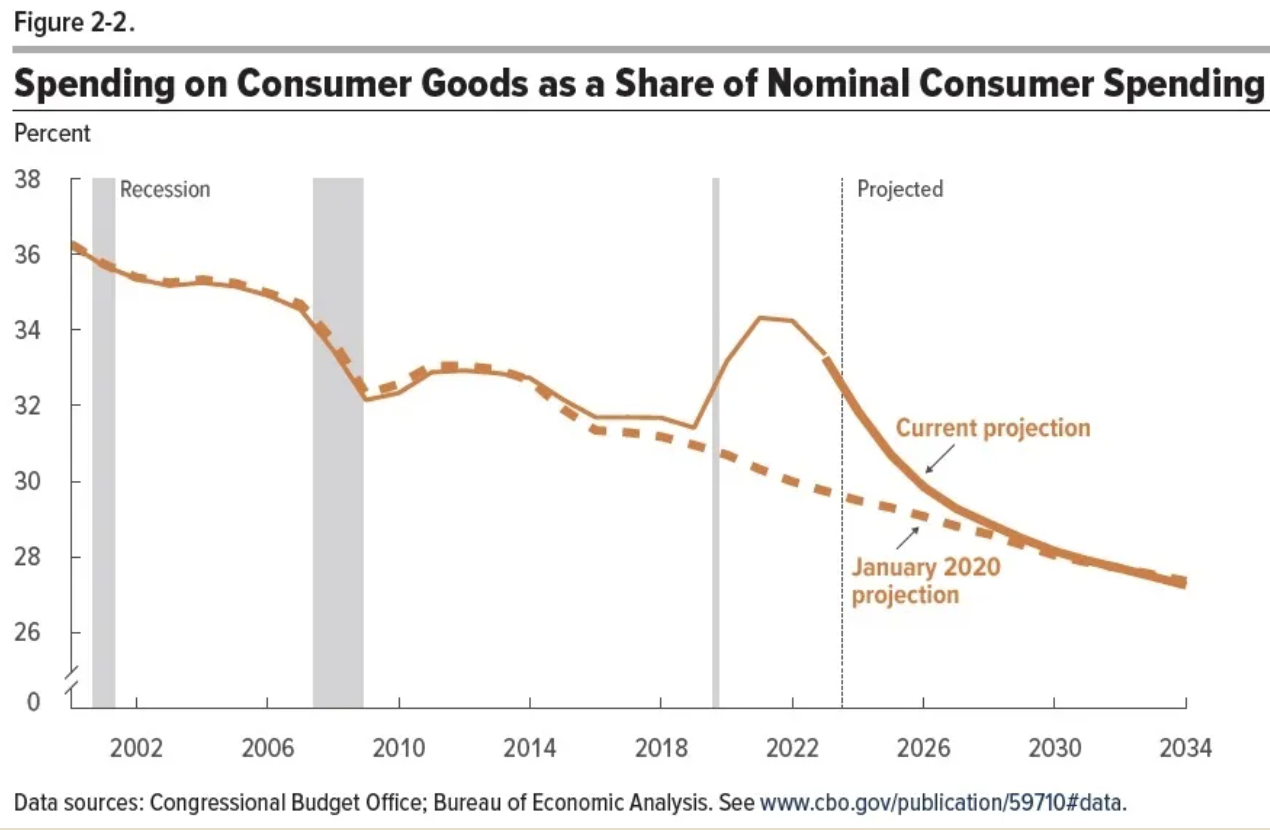Comments
- No comments found

When people think about what an economy produces, they tend to think in terms of solid objects: cars, appliances, clothes, houses, food.
But US consumers are in the midst of a long-term shift away from consuming goods and toward consuming services. Here’s an illustrative figure from the Congressional Budget Office (The Budget and Economic Outlook: 2024 to 2034, February 2024).

Here are a few ruminations:
1) The decline is fairly rapid, from 36% of consumer spending going to goods in 2000 to only about 30% at present–and if the CBO projections are to be believed, a continuing trend for the next decade.
2) The US economy is not mostly composed of material objects. It’s much more services than goods.
3) In practical terms, what does this shift mean? Major categories of services include health care, education, entertainment and tourism, finance, and the like. As my wife and I have paid college tuition bills for multiple children over the years, we say that it’s the equivalent of buying a very nice car and driving it off a cliff each year. But we choose the college tuition, although our cars are more than a decade old. More generally, we try to choose (without being in any way extreme about it) to consume experiences rather than to accumulate stuff.
4) The distinction between goods and services remains meaningful: for example, issues of production, supply chains, and how they are provided to ultimate consumers are systematically different. But it’s also worth remembering that even within the category of “goods,” there are a lot of embedded services. When someone buys a car or a smartphone or a pair of jeans or a cart full of groceries, the physical objects they are buying include a substantial dose of underlying service activities like research, design, marketing, finance, management, and transportation. In that sense, the fact that services are 70% of consumption surely underestimates their importance in an high-income economy.
Timothy Taylor is an American economist. He is managing editor of the Journal of Economic Perspectives, a quarterly academic journal produced at Macalester College and published by the American Economic Association. Taylor received his Bachelor of Arts degree from Haverford College and a master's degree in economics from Stanford University. At Stanford, he was winner of the award for excellent teaching in a large class (more than 30 students) given by the Associated Students of Stanford University. At Minnesota, he was named a Distinguished Lecturer by the Department of Economics and voted Teacher of the Year by the master's degree students at the Hubert H. Humphrey Institute of Public Affairs. Taylor has been a guest speaker for groups of teachers of high school economics, visiting diplomats from eastern Europe, talk-radio shows, and community groups. From 1989 to 1997, Professor Taylor wrote an economics opinion column for the San Jose Mercury-News. He has published multiple lectures on economics through The Teaching Company. With Rudolph Penner and Isabel Sawhill, he is co-author of Updating America's Social Contract (2000), whose first chapter provided an early radical centrist perspective, "An Agenda for the Radical Middle". Taylor is also the author of The Instant Economist: Everything You Need to Know About How the Economy Works, published by the Penguin Group in 2012. The fourth edition of Taylor's Principles of Economics textbook was published by Textbook Media in 2017.
Leave your comments
Post comment as a guest